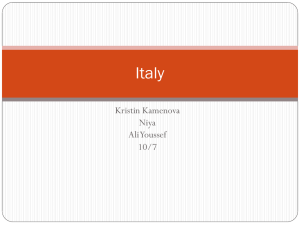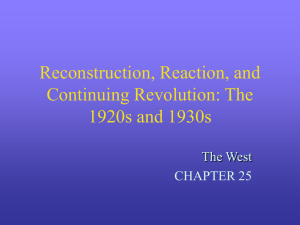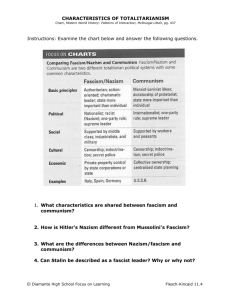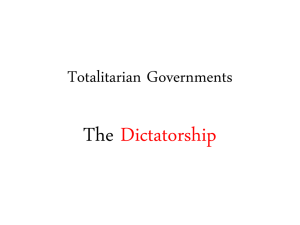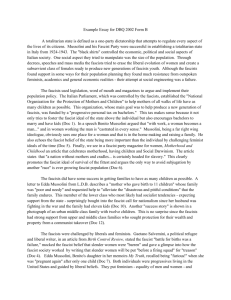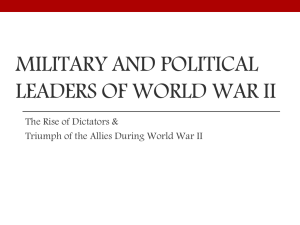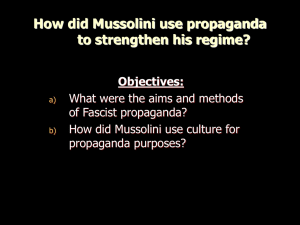The Festival State: Celebration and
advertisement
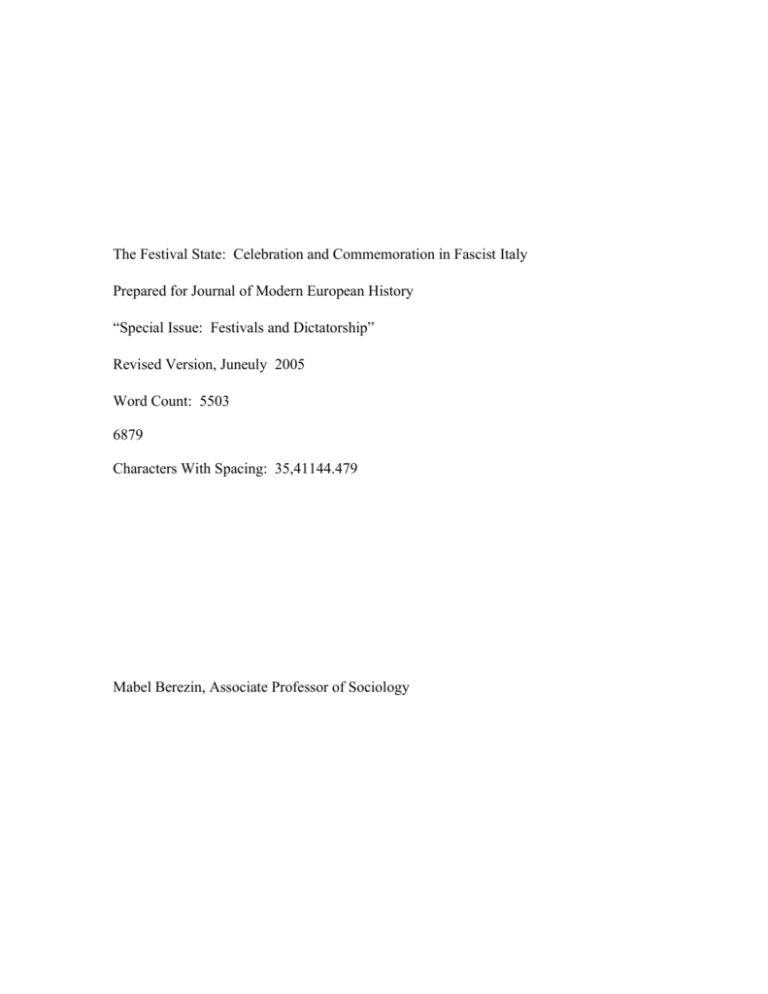
The Festival State: Celebration and Commemoration in Fascist Italy Prepared for Journal of Modern European History “Special Issue: Festivals and Dictatorship” Revised Version, Juneuly 2005 Word Count: 5503 6879 Characters With Spacing: 35,41144.479 Mabel Berezin, Associate Professor of Sociology 2 Abstract (Characters: 785) Fascist Italy was a festival state. The National Fascist Party and Italian Ffascist ? regime staged celebratory and commemorative events in the Italian periphery as well as the Roman center. Festival was part of ordinary Italian life from the late 1920s to the fall of Mussolini’s regime in 1943. Festivals drew upon a repertoire of ritual actions and derived their emotional force from the manner in which they combined and repeated ritual forms. Three sites of festival are the focus of this article: the city of Verona; travelling theatre cars (carri di tespi); and the annual commemoration of the March on Rome. Fascist Italy was not alone in its festival strategy. Every nation building project eventually turns to the task of celebrating and commemorating itself. Borrowing from sociologist Georg Simmel, the article argues that festival is the “play-form” of politics because it uses theatricality to communicate political legitimacy. 1I. Fascism and Festival Festival is a formal cultural category that captures a range of public, collective and expressive activities. Religious in origin, festivals became secular in the early modern period when astute political actors from kings to revolutionaries began to map them onto political activity.1 In contrast to more instrumental forms of political behavior such as taxing and war-making, the expressive politics of festival serves to give narrative form and emotional valence to the everyday “business of rule” that characterizes the modern nation-state--independent of ideological orientation.2 Festivals engage the populace in rites of collective spectacle. They assume many forms from the purely celebratory to the commemorative. Celebrations are present oriented. They aim to promote community and solidarity among groups in public spaces. Celebrations contribute to the on-going feeling of belonging to the polity. They are also entertaining—that is they have the capacity to create the feeling of festivity—or playfulness.3 In contrast to celebration, commemoration speaks to the past. In the political sphere, commemorations are venues of official history making.4 1 For the modern period, see M.Ozouf’s classic work, Festivals and the French Revolution, trans. A. Sheridan (Cambridge/MA, 1988). C. Geertz, Negara: The Theatre State in Nineteenth Century Bali (Princeton/ NJ, 1980) provides a non-Western example. 2 G. Poggi, The Development of the Modern State (Stanford/CA 1978), 1-15. 3 See V. Turner, From Ritual to Theater: The Human Seriousness of Play (Performing Arts Publications/NY 1982) 4 On this point, see L. Spillman, Nation and Commoration (Cambridge/UK 1997) that Commemorations mark events, persons and days as important to an on-going public narrative of the national and local polity. Italy in the pre-modern and the modern period had a rich legacy of festival that included the religious rituals of the Catholic Church as well as the improvisational culture of the commedia dell’arte.5 [and festivals of the risorgimento ?] In the 1880s, the Italian state began to cultivate the modern culture of festival when it instituted the ritual of national pilgrimages to commemorate the Risorgimento.6 Fascist Italy skillfullly appropriated the Italian culture of festival—expanding on the secular and commemorative events that the architects of a unified Italy deployed in the latter half of the nineteenth century.7 Festivals--commemorative and celebratory compares Centennial celebrations in the United States and Australia. On fascist Italy, see C. Fogu, The Historic Imaginary: The Politics of History in Fascist Italy (Toronto/Canada 2003). 5 P. Toschi, Le Origini del teatro italiano (Turin/ Italy 1955); I Porciani, La Festa della nazione (Milan/Italy 1997). 6 B. Tobia, Una Patria per gli Italiani: Spazi, itinerary, monumenti nell’Italia unita (1870-1900) (Rome/Italy 1991), 100-159. 7 S. Cavazza, Piccole Patrie: Feste popolari tra regione e nazione durante il fascismo (Milan/Italy 1997) demonstrates how the regime appropriated regional festivals and wed them to a national culture of tourism. D. M. Lasansky, The Renaissance Perfected: Architecture, Spectacle and Tourism in Fascist Italy (University Park/PA, 2004) studies events--under the combined jurisdiction of the National Fascist Party and Italian fascist state, were staged in the periphery as well as the Roman center, and became part of ordinary Italian life from the late 1920s to the fall of Mussolini’s regime in 1943.8 Celebration and commemoration are central to political projects of various ideological hues. Without loyal members, i.e., citizens or subjects, who identify with its project, a state will be at a comparative disadvantage in international relations and competition. On the other hand a state cannot create new identities from whole cloth. The existing identities from which it borrows or appropriates may undermine or enhance its political project. In the Italian case the “popular culture of Roman Catholicism,” and the “cult of the mother” were the cultural tropes that underlay fascist celebratory and commemorative events. The popular practice of Roman Catholicism, engraved in the mental frames even of anti-clerical fascists, was available for cultural and political transposition. Likewise, the “cult of the mother” that appropriated a visceral Italian feeling about the nature of motherhood, lent itself to commemorative purposes. Fascist Italy was a festival state. Public festivals drew upon a standard repertoire of ritual actions and symbols (for example, the Roman salute, the Black Shirt) and derived their emotional force from the manner in which they combined and repeated these ritual forms. In short, ritual practices were the resonating components of the celebratory and urban design in Tuscany and shows how the fascist regime appropriated the Renaissance aesthetic in the service of tourism. 8 M. Berezin, Making the Fascist Self: The Political Culture of Interwar Italy (Ithaca/NY 1997) details these events. commemorative fascist whole. [here: an outlook on the specific nature of festivals in dictatorships / Fascist Italy] This article aims to evoke a sense of how the Italian fascist regime deployed festival in the service of its broader political goals. It focuses upon three festival sites: first, celebration in Verona; second, travelling theatre cars (carri di tespi); and third, the repertoires of ritual that the regime developed around the annual commemoration of the March on Rome. It concludes with general remarks on the role of festival and dictatorships specifically, as well as festival and politics.political culture more generally. 2II. : Festival as Disruption and Appropriation: Celebration and the Rhythm of Daily Life in in Verona, Italy 1922-1942 The relatively small northern Italian city of Verona provides a window on the kinds of festival activities that took place during the years of the Italian Ffascist ? regime. A detailed calendar, a log, of public political events left by an industrious fascist party administrator reveals a distinct pattern. 9 Between 1922 and 1942, fascism set the rhythm of public life in Verona. During this period the Veronese Fascist Party staged 727 public events. These events ranged from small mundane affairs such as a local official's speech on some feature of fascist ideology to the relatively rare event of a large public spectacle.10 Celebrations dominated Veronese public life during the fascist period. These 9 On the calendar, see Berezin, Fascist Self, 256-258. 10 Ibid., pp. 141-195 provides a full description of life in Verona during this period. included visits of distinguished persons such as Mussolini, on-going fascist events such as the leva fascista, birthdays of living fascist heroes, as well as sporting and theatrical events. Fascist celebration in Verona during 1932, the year which marked the Tenth Anniversary of the March on Rome, provides an example of the range of events that celebration as a category subsumes. 11 In March 1932, Luigi Razza the head of the National Fascist Agricultural Union visited Verona to celebrate a day dedicated to the Rural Housewives [Massaie Rurali]. In April, almost daily propaganda meetings were held throughout the province by order of the National Fascist Party head. Verona celebrated the Birth of Rome [Natale di Roma] on April 21 with the "symbolic rite" of the leva fascista. In May, veterans, fascists and the "people" enthusiastically participated in propaganda meetings [raduni di propaganda]. On July 3, there was a "vibrant day of fascist faith." August saw the Carabinieri the civil police march, a display of tactical maneuvers and a military parade. On September 8, there was a "powerful fascist manifestation" to signal the changing of the guard at the Federation of Fighting Fascists. On October 9, there was an "extremely grand meeting" [grandiosa adunata] of youth to celebrate the presence of high level national fascist party members at the annual young fascist celebration. On October 30 members of the fascist 11 s The source for the events described in this section is : Partito Nazionale Fascista (PNF), Federazione dei Fasci di Combattimento di Verona, « Documentario manifestazioni della Federazione Fascista dal 23 gennaio 1922 al 19 luglio 1942-xx » (typescript) Archivio Centrale dello Stato (ACS),PNF, MRF, b.12 (Verona). here and the following pages: please indicate a variety of important sources ource ? – youth organization again staged a "vibrant patriotic manifestation" at the Teatro Nuovo. The last celebratory event of the year was the departure on December 9 of 600 Veronese peasants [rurali] for the fascist province of Littoria. Exporting unemployed peasants and workers to either the African colonies or planned communities in Italy was a standard fascist strategy to deal with the economic distress of the thirties. The farewell event included a Mass in the Cathedral where the Bishop imparted his blessings and a ceremony at the train station where the local fascist party head and the local leader of the agricultural union delivered speeches. The April 21 celebration of the Birth of Rome occurred annually in Verona until 1942. The Birth of Rome was a national fascist holiday that subverted Catholicism and Socialism. The fascist "feast of labor", the Birth of Rome, aimed to attenuate whatever feelings remained for the Socialist's celebration of labor on May 1. The ceremony of the leva that was an integral part of the April 21 celebration imitated the Roman Catholic Confirmation ceremony. The leva was a "rite of passage" in which fascist youth passed from one level of sub-organization of the Fascist Party to the next. The leva ceremony took place throughout Italy with the largest ceremony occurring in Rome before Mussolini. The disruption of work time and the appropriation of leisure time characterized Fascist festival activity in Verona. The fascist party log allows us to determine Tthe day of the week on which fascist public events occurred. can be reconstructed from the Verona calendar. The timing of events suggests how fascist festival interrupted the flow of ordinary life in Verona. A third of festival events took place on a Sunday--a day with distinct ? secular and religious meaning. The Italian state mandated that Sunday was a day of rest from labor; the Roman Catholic Church obligated its members to attend Mass on that day. The events that occurred on Sunday interrupted customary leisure and religious practices. In a country such as Italy where schooling was often an ad hoc event and truancy rates were high, weekly participation in the Roman Catholic Mass was one of the few cultural practices that had any ability to command a constituency. Only 7 percent of events occurred on a specifically designated fascist or national holiday suggesting that the Sunday events, a usurpation of religious ritual time, was a fascist strategy to undermine the hold that the Catholic Church had on the mental lives of Verona's citizens. The timing of tThe majority of the events occurred on days that would ordinarily be work days which suggests that thesefestival events dwere disruptiveed of the routine work activities of the participants and spectators.. The timing as well as the sheer volume of events in Verona made the festivals and by extension, the fascists difficult to ignore. By ritually colonizing time and space in this small city, fascism imposed itself on the populace—independently of their level of political commitment to the regime. the argument is not quite clear at this point; please add 1 to 2 paragraphs of further elaboration of your interpretation 3III. Festival as Festivity: The Travelling Thespian Cars In 1927, the Dopolavoro, the fascist leisure organization, received 235,000 lire from the Fascist regime to develop cultural activities for the lower middle and working classes.12 In the years before World War I, Italian Socialists had developed an active theatrical culture, people’s theatre, for the purposes of political socialization and education.13 The Dopolavoro appropriated the early Socialist theatrical experiments and created their own version of people’s theater, the travelling Thespian Cars (carri di tespi). The Dopolavoro put the Thespian Cars on the road in 1929. Achille Starace, Secretary of the Fascist Party, and Giovacchino Forzano, a prolific playwright of the 1920s and 1930s, collaborated on the design and direction of the Cars.14 The Dopolavoro’s Cars intended to transport theater to parts of Italy that were culturally barren. In practice this goal did not materialize as the Cars’ itinerary suggests that they did not go too far into the hinterland. The Cars gave their opening performances in Rome to draw national attention to the project. On July 4, 1929, the first Prose Car gave an experimental and free performance in the Piazzale del Pincio, followed by two additional performances at the Piazza Navona and the other at the Fascist Party Stadium. 12 V. DeGrazia, The Culture of Consent: Mass Organization of Leisure in Fascist Italy (Cambridge/UK 1981) is the standard account. 13 E. Scarpellini, Il Teatro del popolo: la stagione artistica dell’Umanitaria fra cultura e societa: 1911-1943 (Milan/Italy 2000). 14 This account relies on M. Berezin, “Cultural Form and Political Meaning: Statesubsidized Theater, Ideology, and the Language of Style in Fascist Italy”, American Journal of Sociology 99 (1994), 1255-1266. See also G. Pedulla, Il Teatro italiano nel tempo del fascismo (Bologna/Italy 1994) and J. T. Schnapp, Staging Fascism: 18BL and the Theater of Masses for Masses (Stanford/CA 1996). The first plays staged were Vittorio Alfieri’s Oresteia and Leopoldo Marenco’s The Falconer of Pietro Ardena. The Car’s first tour was of central Italy. In its first two months of operation, the Car gave 67 performances in 35 little cities. Outdoor performances limited events to the summer season. 15 The Cars arrived in town a day before a performance and the company set up their portable stage in the town square. The Cars were as disruptive of the rhythm of daily life when they appeared as other fascist festivities. Fascist propaganda emphasized the modernity and technical complexity of the stage, the efficiency with which the cars moved from town to town, and the popular acceptance of the cars. Pictures of these events reveal a startling incongruity between the old town squares and the makeshift, but technologically advanced, stages. The medieval world appears to collide with the new technological world without any rationale except to impress upon the audience the contrast between the last period of Italian greatness and the new period of expected greatness. According to fascist propaganda, audience response to the Cars was enthusiastic. A theatre historian noted, “[The car] seemed like a gift of the Regime; and a greatly effective gift it was. The public, coarse but intelligent, compressed and strained their astonished eyes in front of the spectacle: the first that many had attended. . .The travelling actors were welcomed and greeted as messengers bearing happy news, and in many 15 M. Corsi, Il Teatri all’aperto in Italia (Milan/Italy 1938), 277-82 describes the repertory and provides data on the number of performances. here and following pages: please indicate sources places they were asked to stay longer, or to return.”16 The head of the theatre division of the Ministry of Popular Culture argued that the Cars gave, “. . a new character to the Italian theatre and one fully in keeping with the spirit and ethics of Fascist doctrine.17” “Spirit” as a popular aesthetic was novel to fascism and defined its vision of theater. Fascism inverted and subverted the Socialist theatrical vision by shifting the location of dramatic affect from the mind to the soul, from cognition to emotion, from the rational to the non-rational. In doing so it aimed to re-define the people as a community of feeling rather than a community of cognition. For the majority of the Italian population, this meant submerging their individuality, their private selves, in the public political community of the nation. Fascist cultural rituals such as theatre eradicated the boundary between public and private self as did fascism itself.18 Giovanni Gentile, the Italian philosopher and regime intellectual, underscored the importance of the fusion of public and private by comparing the practice of fascism to the practice of Catholicism. Gentile argued that both fascism and Catholicism refuse to separate the private from the public. Gentile in a 1925 speech entitled, What is Fascism ? argues : One cannot be a fascist in politics and not fascist . . . in school, not fascist in one’s family, not fascist in one’s work. Like a Catholic, if one is Catholic, one invests his whole life with religious sentiment . . . if one is truly Catholic . . . one 16 Ibid., 268.M. Corsi, Il Teatri all’aperto in Italia (Milan/Italy 1938), 268. 17 N. De Pirro, Il Teatro per il popolo (Rome/Italy 1938), 67. 18 On ritual and its relation to the public and private, see Berezin, Fascist Self, 245-251. remembers always in the highest part of one’s mind, to work and think and pray and meditate and feel Catholic ; so too a fascist, who goes to parliament, or to the fascist house, writes in the newspapers or reads, them follows his private life or converses with others, looks to his future or thinks of his past and the past of his people, ought always to think of himself as a fascist !19 The theater and the church were spatial arenas of aesthetic and religious emotion designed to evoke the feeling of total commitment that fascism and Catholicism required. Fascism and Catholicism may have had a similar ritual form and emotional valence, but this, as the next section suggests, does not imply that they were in harmony. here something on the “New Italian” as a New Man could be said; also the didactic potential of Fascist festivals could be highlighted: festivals as an didactic (Sorry I do not agree with this interpretation—maybe the Germans or the Russians were didactic but the Italians were expressive instrument to forge the new man/person please add 2-3 paragraphs of interpretation 4IV. Holidays as Commemorative GenresSites of Church/State Contestation maybe also: as an contested field … (see the confrontation of Church and Fascist rituals) 19 “Che cosa e il fascismo?” in Giovanni Gentile: Politica e Cultura, ed. Herve A. Cavallera, vol. 2 (Florence/Italy 1991), 86. Under Italian fascism, commemoration took three forms: first, the design of a new national calendar of official holidays; second, the staging of large public events, mostly on national holidays but sometimes on an ad hoc basis; and third, commemorative ceremonies around fascist heroes that were often embedded within larger public events.20 The fascist regime redesigned the official calendar of holidays four times between 1923 and 1940. 21 Its first official act was to abolish the Socialist holiday of May Day celebrated on May 1 and to replace it with April 21--the reputed anniversary of the Birth of Rome and new fascist labor day. While the Socialist holiday was eliminated by fiat, Catholic holidays, which were also national holidays, proved a less easily solvable dilemma to a regime that wished to keep the Church as an ally. The 1930 holiday law that remained in effect until 1941 when the war effort demanded a reduction in holiday time appeared to adjudicate the conflict between Church and State over official holidays. The law recognised 13 Catholic holidays as well as every Sunday--as a legislated day of rest and celebration. A holiday to celebrate the 1929 Concordat and one to commemorate the founding of the Fascist Squads replaced the “Statuto,” a national holiday that antagonized the Church because it commemorated the unification of Italy that had kept 20 Chapter 3 and Chapter 4 of Berezin, Fascist Self p,rovide the material for Sections IV and V C.hapters 3 and 4 is the source for Sections IV and V. 21 Archivio Centrale dello Stato (ACS) Rome, Presidenza del Consiglio dei Ministri (1937-39) (PCM) 3.3.3/f.1558, sf. 8, “Pro-Memoria” summarizes the fascist legislation on holidays. the Pope a virtual prisoner. 22 Closer inspection of the 1930 law reveals that the regime positioned civil and national holidays in close proximity to Catholic holidays—thus intensifying, rather than resolving and intensified, rather than resolved, the conflict between Church and State. For example, in 1926 an official of the Ministry of Corporations the body that regulated labor relations in fascist Italy asked Mussolini how the General Confederation of Industry would justify giving workers a day free from labor on October 28th and November 4th, the dates that commemorated the fascist “March on Rome” and the World War I battle of the "Vittoria," but force them to work on November 1, "All Saints Day," the "holiest Catholic holiday." 23 The timing of the "March" and the "Vittoria" commemorations were not the only state holidays that trespassed on Catholic holiday terrain. As noted in Section II, the regime positioned March 23, the date of the "Founding of the Fascist Squads" and April 21 the "Birth of Rome" so that they would inevitably interfere with Easter celebrations that always occurred at some point between the end of March and the end of April.. 2 paragraphs more on the conflict of Church and Party-State festivals The anniversary of the “March on Rome,” the mélange of events that brought fascism, to power, became an official holiday on October 28, 1923. When Italian troops marched on 22 footnotes lacking: please indicate some used sources 23 “Appunto per S.E. Il Capo del Governo,” 22 October 1926, ACS, PCM 1926 2-4-I, f. 3904. Rome in 1870, they completed the Risorgimento project and made Rome the capital of the new Italy. The march of Mussolini's black shirts began the fascist project. The liberal Italian state builders did not emphasize the 1870 "March" and it became a schoolbook piece of dead history--a wasted cultural resource in a repertoire of possible national symbolic actions. The fascist regime did not relegate its "March on Rome" to textbooks--even fascist textbooks. V. Repertoires of Ritual: The March on Rome The anniversary of the “March on Rome,” the mélange of events that brought fascism, to power, became an official holiday on October 28, 1923. When Italian troops marched on Rome in 1870, they completed the Risorgimento project and made Rome the capital of the new Italy. The march of Mussolini's black shirts began the fascist project. The liberal Italian state builders did not emphasize the 1870 "March" and it became a schoolbook piece of dead history--a wasted cultural resource in a repertoire of possible national symbolic actions. The fascist regime did not relegate its "March on Rome" to textbooks--even fascist textbooks. [unclear: why? what does it mean?] The annual commemoration of the "March on Rome" established a repertoire of ritual action around political themes that the regime would draw upon for its duration. These actions included parades through the center of the city, homage to dead fascist heroes, and public display of fascist bodies--particularly mothers and soldiers. Starting the first anniversary in 1923 and changing according to national and international circumstances, it continued until the regime fell in 1943. October 28, the date of the “March,” became an annual public opportunity to re-invent and re-narrate the founding event, as well as to assess in public space where the regime had been and where it was going. By narrating and re-narrating, acting and re-enacting the founding event, the regime merged the fascist present with its past and laid the foundation for its future. The annual dramatic re-enactment imposed the memory of the March on all Italians-from the committed to the indifferent to the regime’s avowed enemies. Branching from the Roman center, commemorative events coated the Italian landscape. Mussolini or his emissaries made pilgrimages to sites of fascist history; Italian soldiers re-enacted battle scenes. During the 1920s and 30s, narratives of commemorative events appearing in Il Popolo D’Italia, the National Fascist Party’s daily newspaper, provided a running chronicle of the fascist project.24 (NB there is no source for this other than mfs—that’s what that books is about) Five patterns of ritual action and narrative evolved within commemorative events over the years between 1923 and 1938. The first was the myth of the founding event. Fascist rhetoric transformed a myth of national revolution into a myth of a new Roman empire. Fascist history, as recorded in the public spectacle of the March commemorations, deepened with each succeeding year. As the years passed, the differences between the soldiers who gave their lives in World War I and the "fascist martyrs" who gave their lives for the revolution blurred. The destruction of the boundary 24 This is now covered in fn 21 footnotes and sources between these two groups coupled with the incorporation of the new generation of Italian, and fascist, youth identified fascism as the regime that redeemed the tainted victory of World War I and looked forward to new wars and new conquests. Empire completed the revolution. The proximity of the commemoration of the March to that of the "Vittoria," – the World War I baattle - the week between October 28th and November 4th, provided an opportunity to create a space of temporal disruption that imposed the regime on the Italian people whether or not they joined in the spectacles of the piazza. The Roman salute, Mussolini's transformation from "Duce" to "Dux," the parading around Roman ruins and the centrality of Rome itself as commemorative stage attempted to re-invent the grandeur of ancient Rome in modern Rome. Colonialism and empire, war and Romanism never completely eclipsed "revolution" in the commemoration of the March. Beginning in the 1930s with the imperialist aspirations of the regime on the rise, commemorations assumed a more militaristic hue. The mobilizations of the mid-1930s were devoid of cognitive content and were pure displays of emotion in the service of generating national solidarity. please add a sentence on the interrelationship of festivals and images of the enemy: festivals as displays /manifestations of the enemy etc. The second pattern was to the the forging of enemies and heroes. Enemies create bonds of solidarity and intensify feelings of community. In its early days, the regime clearly identified socialists as its enemy. Choice of commemorative sites, such as “red” Bologna, as well as official visits and inaugurations of the Case del Fascio, which were in many cases old socialist union halls, suggested that the fascists had conquered the socialist enemy. As the regime became more entrenched, the socialists lost viability as an enemy. For example, "not words, but works," the slogan of the fifth anniversary commemoration suggested that the only obstacle to work was the tendency towards lack of discipline among Italian workers.25 Enemies shifted from internal enemies to external ones, from groups to nation states and their leaders. By the 1930s, a new enemy emerged--the individualism touted by liberal capitalist regimes that threatened the fascist ideal of collectivity. Although anti-liberalism was salient in the Labor Charter and the Doctrine of Fascism, it was much more difficult to target as an enemy than socialists. In the years between the invasion of Ethiopia and Italian entry into World War II, national enemies multiplied and provided a focus for fascist emotional commitment. Anti-liberalism took the form of a generalized attack against liberal democratic leaders whom the fascists characterized as warmongers. In the 1930s, France, Britain and the United States, the entire League of Nations, as well as Africans, Jews and capitalists of all stripes joined the amorphous communists, socialists and liberals that had formed the early cadres of fascist enemies.26 In addition to looking outward to international enemies, the regime sought to identify exemplary fascist heroes. Michele Bianchi-one of four apostles of the regime listed in La Nazione Operante--was a central figure in the tenth anniversary commemorations. A member of the March's Quadrumvirato, he died in 1927 and was accorded a state funeral 25 Benito Mussolini, « Nel V. annual della Rivoluzione, » Partito Nazionale Fascista, Foglio d’ordini, 28 Ottobre 1927, #39, 1. footnotes, sources 26 Berezin, Making Fascist Self, 138. footnotes, sources in Rome. Guglielmo Marconi, the inventor of the wireless, also figured prominently in the tenth anniversary commemorations as an example of a new Italian fascist cultural hero. The third pattern was the appropriation of the commonplace. Mussolini's 1923 visit to the Perugina factory and his frequent attendance at sporting events and concerts suggested that fascism had placed its stamp upon both work and leisure--public and private time. The annual dedication of public works that occurred on October 28th replaced the earlier commonplace of factory visits. The regime celebrated the infrastructure that it built on the anniversary of the "March on Rome"--an infrastructure that included new roads, schools, dams, post offices and other public buildings, which Italians would see and use on a daily basis.27 The "day of faith" and the "wedding ring campaign" represented a shift in the familiar pattern of regime appropriation of the objects of everyday life from the somewhat public to the intensely private.28 here also: the project of a “New man”; please add a couple of sentences The “day of faith” occurred on December 18, 1935 and the “women’s mobilization” in Rome occurred on May 8, 1936-three days after Mussolini declared 27 footnotes, sources (NB, don’t think we need a footnote here other than MFS cites-it is a routine, not something special) 28 “La memorabile giornata a Roma,” Il Popolo d’Italia, 19 December 1935, 1 provides a description of the day. victory in Ethiopia and two days before the declaration of Empire. While the latter event simply featured the raw display of masses of women’s bodies in the service of the regime, the “wedding ring campaign” as the former event is known speaks directly to the symbolic weight accorded to family and motherhood. After three months of fighting, the Ethiopian campaign was rapidly emptying state coffers. The regime needed gold and Mussolini asked Italian women to sacrifice their wedding rings to the glory of the nation. There were ceremonies throughout Italy to donate wedding rings. The main ceremony occurred in Rome on the steps of the Monument to Victor Emanuel. The Queen of Italy led Italian mothers and wives to the “Altar of the Patria” where they donated their wedding rings to the nation. The fascist appropriation of marriage's principal public symbol underscored the regime's continuing attempt to draw the family into the community of the state. The fourth pattern was the merging of sacred and secular. The inclusion of the Catholic Church in fascist commemorative activity and the insertion of fascist ritual activity into Catholic liturgy was a fascist strategy to usurp a familiar Italian sacred ritual space that began in 1923 with the Mass in Piazza Siena. Celebrated in the Piazza Siena in Rome, and simultaneously in every part of Italy, this particular Mass served as a symbolic enactment of the new national unity that fascism had brought.29 The elevation of the Eucharist, the point at which the priest recites the words that change ordinary bread and wine into the body and blood of Christ, is the center of the Catholic 29 “La messa al campo Piazza di Siena,” La Tribuna, 30 Octobre 1923, 4.footnotes, sources Mass. The Mass in the Piazza Siena inserted fascist ritual practice into the most sacred part of the liturgy. At the moment the priest raised the Eucharist and turned to the audience, a trombone sounded, the troops presented arms and the fascist raised their arms in a Roman and fascist salute. As the priest consecrated the Eucharist, the fascists consecrated themselves and blurred the distinction between what was sacred and what was secular--what was Church and what was State. The fascist imposition upon Catholic ritual suggested that one could be both fascist and Catholic. The fifth and final pattern was the transfiguration of bodies into cultural icons. From the first anniversary commemoration, the public display of mothers' and widows’ bodies served as living icons that merged the public and private self and contrasted with the discourse of emotion and sexuality that permeated fascist political rhetoric. The presence of the mothers and widows of fallen fascists and war casualties was a constant in the commemoration of the March in particular and fascist public spectacle in general. The regime used the display of mothers' bodies to appropriate the idea of motherhood, a powerful Italian cultural ideal, and to make it resonate with the ideal of the nurturing and stable fascist State. As the years progressed, the use of bodies as cultural icons became more articulated with an idea of a growing fascist public. Soldiers and fascists populated early commemorative events. But as the regime expanded its influence, it was able to mobilize more bodies-ordinary Italian men and women. As the fascist party grew to include youth and women's organizations, the boundaries of what would constitute a fascist public expanded. The massing of bodies in the service of public display culminated in the mobilizations of the 1930s.30 The people’s adunate that began in 1935, the year that the regime invaded Ethiopia, were huge rallies that brought masses of persons into public squares throughout Italy to demonstrate solidarity with the regime’s imperialist ventures. The pictures of these events in Popolo d’Italia are blurry and suggest a raw mass of living bodies giving consent to the regime. The newspaper headlines shout the Imperial aspirations of a regime that was inventing colonies and imagining empire. There were six national adunate in Rome between 1935 and 1937. Four of them focused on the war in Ethiopia and the founding of the fascist empire; Italian women were the focus of the other two. By wedding maternal to military representations, the adunate merged nation and family.31 The ceremonies that signalled the success of the Ethiopian campaign to the Italian people suggest the tenor of these events. To celebrate the fascist “victory” in Ethiopia, Mussolini ordered an adunata in Rome of 500,000 persons. Addressing the assembled crowd from the balcony of Palazzo Venezia, he proclaimed using the language of colonial conquest: “Ethiopia is Italian! Italian in fact, because it is occupied by our victorious armies; Italian in law, because of the Roman gladiators, and the civility that triumphs over barbarism, the justice that triumphs over arbitrary cruelty, the redemption of miseries that triumphs over a millennium of slavery.” The crowds gathered in all of 30 Berezin, Fascist Self, footnotes, sources 121-127. 31 “Il Duce annunzia all’Italia ed al mondo la costituzione dell’impero fascista,” Il Popolo d’Italia, 6 May 1936, 1; Italia Imperiale, ed. Giovanni Agnelli and Achille Starace (Milan/Italy 1937).footnotes, sources the piazzas of Italy and bells peeled from the church towers and public buildings of the medieval Italian landscape. Cheering Italians filled the streets of central Rome from the Via del Impero to Corso. Three days later on May 9, 1936, Mussolini declared Italy an Empire. 6VI. Festival Under Dictatorship: Belonging Without Voice Festival: The “Play-Form” of Politics The modern nation state, the political form that has dominated Europe since the 18th and 19th century, is a two pronged entity. State building, the demarcation of territorial boundaries, occurred before nation building—the creation of a common culture. As Eugen Weber, as well as other historians after him, has shown “peasants” did not automatically become “French men” when the boundaries of modern France were drawn.32 It took the culture building projects of the Third Republic—language consolidation, school standardization and military service to make a France where state and culture were in synchrony.33 If we look to France as the paradigmatic nation-state project then Italy was “behind” on many fronts. It became a unified territory, relatively late in 1860, regional languages and dialects were the dominant modes of communication, literacy rates were low and the school system was primitive.34 Massimo D’Azeglio’s oft quoted remark, 32 See E. Weber, Peasants Into Frenchmen (Stanford/CA 1976). 33 S. Hazareesingh, From Subject to Citizen (Princeton/NJ 1998) 34 B. King and T. Okey, Italy Today (James Nisbet/London 1904) provide the standard “Having made Italy, we must now make Italians” is a virtual cliché. Making an Italian national culture was the Resorgimento project and it was far from complete when Benito Mussolini took over the reins of government in 1922. A common spoken language and literacy in that language is the glue of a modern national state. The fascist regime worked to reform the schools and consolidate the language.35 But, education is a slow, not an immediate process. The fascists required a cultural form that would accelerate the process of cultural, national and ultimately fascist cohesion. For this the regime turned to the politics of festival. Every nation building project eventually turns to the political-cultural task of celebrating and commemorating itself. The Italian fascist regime engaged in a festival culture that had variants in revolutionary France, Nazi Germany, state socialist societies and even the United States.36 If festival is so pervasive in politics no matter what the contemporary account in English of Itallian political and cultural institutions in the immediate post unification period. 35 See G. Klein, La political linguistica del fascismo (Bologna/Italy, 1986) and M. Barbagli, Educating for Unemployment (Columbia/New York, 1982). 36 The classic study of the French Revolution is L. Hunt, Politics, Culture and Class in the French Revolution (Berkeley/CA 1984). For Nazi Germany, see G. Mosse, The Nationalization of the Masses (Ithaca/NY 1991). The literature on state, culture and nation building has grown exponentially since Hunt and Mosse published their studies. Salient examples are P. Fritzsche, Germans Into Nazis (Cambridge/MA 1998), on Fascist Italy, E. Gentile, Il Culto del littorio (Rome/Italy 1993), on the United States J. Bodnar, ideological orientation of the regime or government under scrutiny, what might we say about it first, under conditions of dictatorship, and secondly more generally as a as political practice? Dictatorship, as well as parliamentary democracy, are forms of governance that are equally compatible with the modern state as organizational form. Where they differ from each other in in how they constitute the relationship between the state and its members, i.e., citizens. The democratic state has four identifiable ways of articulating the relation between ruler and ruled: first, the franchise (granted this was restricted until the post-war period in Europe); second, local association—the legal right to gather; third, public discourse, ie., freedom of speech and press; and lastly, through extra-parliamentary forms of political behavior such as strikes and social protest. Each of these activities evoke a feeling of belonging to the polity. These democratic political practices are legally constituted means of giving voice to citizens. Under conditions of dictatorship, voting and public protest are out of bounds. Association and the venues of shared public communication, such as press and radio are Remaking America: Public Memory, Commemoration and Patriotism in the Twentieth Century (Princeton/NJ 1992), on Romania under socialism, K. Verdery, National Ideology Under Socialism: Identity and Cultural Politics in Ceausescu’s Romania (Berkeley/CA 1991). For a Latin American case, see F. Finchelstein, Fascismo, liturgia e imaginario (Buenos Aires/Argentina 2002) on Argentina in the 1930s. For a summary of literature to the late 1990s, see M. Berezin, “Politics and Culture”, Annual Review of Sociology 23 (1997), 361-383. carefully regulated.37 Under dictatorship, governance is top down and citizens are without voice. Yet, every state needs to have its citizens feel that they belong—whether they actually feel that they belong is another question. The amassing of citizens in public space that festival demands allows citizens to feel minimally part of a crowd of like minded co-nationals and maximally as emotionally committed members of the national state. Festivals under dictators ritualize belonging without voice. In contrast to dictatorships, festivals in democracies have a more limited role. In democracies, voice is a legally constituted through diverse institutions and citizens may engage in a range of practices that encourage the feeling of belonging to the polity. Citizens may choose to show up at Memorial Day parades and 4th of July celebrations. Dictatorships make participation in festival mandatory, or at least the appearance of participation mandatory. In Italy, the National Fascist Party devoted a great deal of time and energy to transporting participants to various festival events and the railroads were complicit when they deeply discounted tickets. Under dictatorship, festival is a necessity; under democracy, festival is an option. 7. Festival: The “Play-Form” of Politics also: what is specific for a) dictatorships and b) Fascist Italy? 37 M. Berezin, “The Organization of Political Ideology: Culture, State and Theater in Fascist Italy." American Sociological Review 56 (1991), provides a typology of cultural production under different political regimes from totalitarianism to liberal democracy. The typology is germane to the issue of festival but not strictly parallel. A crucial difference between political festival and more standard modes of cultural communication is that public festival is always a state activity. Mass media from theater to the press always involve cultural agents who are not necessarily state agents. Festival is a form of sociability. According to German social theorist Georg Simmel, sociability is based on an implicit knowledge of formal rules of behavior that inhabitants of particular cultural and social contexts share. 38 Adding the political to the notion of context extends Simmel’s theory. Simmel juxtaposes sociability, or form, against values, or content. He argues: “Where a connection, begun on the sociable level…finally comes to center about personal values, it loses the essential quality of sociability and becomes an association determined by a content—not unlike a business or religious relation, for which contact, exchange, and speech are but instruments for ulterior ends, while for sociability they are the whole meaning and content of the social processes.”39 Sociability is an end in itself—it is “the play-form of association [emphasis in original].” 40 The transgression of sociability lies in the violation of the form of association. Participants in a “sociable” interaction who share a culture recognize the transgression.41 A guest at a dinner party who shifted the conversation to private woes or asked personal questions of members of the group would violate the form of the engagement. Dinner parties, as other parties, are transient and expressive articulations of collectivity. 38 G. Simmel, “Sociability”, in Individuality and Social Forms, ed. D. Levine (Chicago/Il 1971), 127-40. 39 Ibid., 131. 40 Ibid., 130. 41 A guest at a dinner party who shifted the conversation to private woes or asked personal questions of members of the group would violate the form of the engagement. Dinner parties, as other parties, are transient and expressive articulations of collectivity. Moving from Simmel’s insights on social forms to politics is a short step. The narrative content of celebration and commemoration is particular to the historical and ideological context that generates it. Festival forms, celebratory and commemorative practices are peculiarly resistant to time and space—history and culture. Italian fascists and Hungarian post-Communists re-bury dead bodies.42 Ideological context, the demands of the political cultural task at hand, determines whose body is chosen for re-burial. Festival form is invariant; festival content depends upon the demands of the particular political regime. Political festival is the “play-form” of politics. Form in politics, as in social life, derives its power from its familiarity. Form is taken for granted because it limits the parameters of interaction and defines the boundaries of transgression. This dimension of festival suggests why the fascist regime was obsessed with timing, holidays and ritual repetition. Festival as a political form articulates what is legitimate and what is not. Festival as the “play-form” of politics uses theatricality to communicate the boundaries of political legitimacy—and it does not really matter who or what is on the stage. more on distinct nature of festivals in a dictatorship and in Fascist Italy: please add 1-2 pages maybe including the comparison of Fascist and Nazi dictatorship: what is common, what 42 See K. Verdery, The Political Lives of Dead Bodies (NY/NY 1999). On the meanderings of the body of Mussolini, after the fall of the fascist regime, see S. Luzzatto, Il Corpo del Duce (Turin/Italy1998). is specific? was there a transfer of festival knowledge between the two regimes? Department of Sociology 354 Uris Hall Cornell University Ithaca, NY 14853 Telephone: 607-255-4042 Fax: 607-255-8473 E-mail: mmb39@cornell.edu

